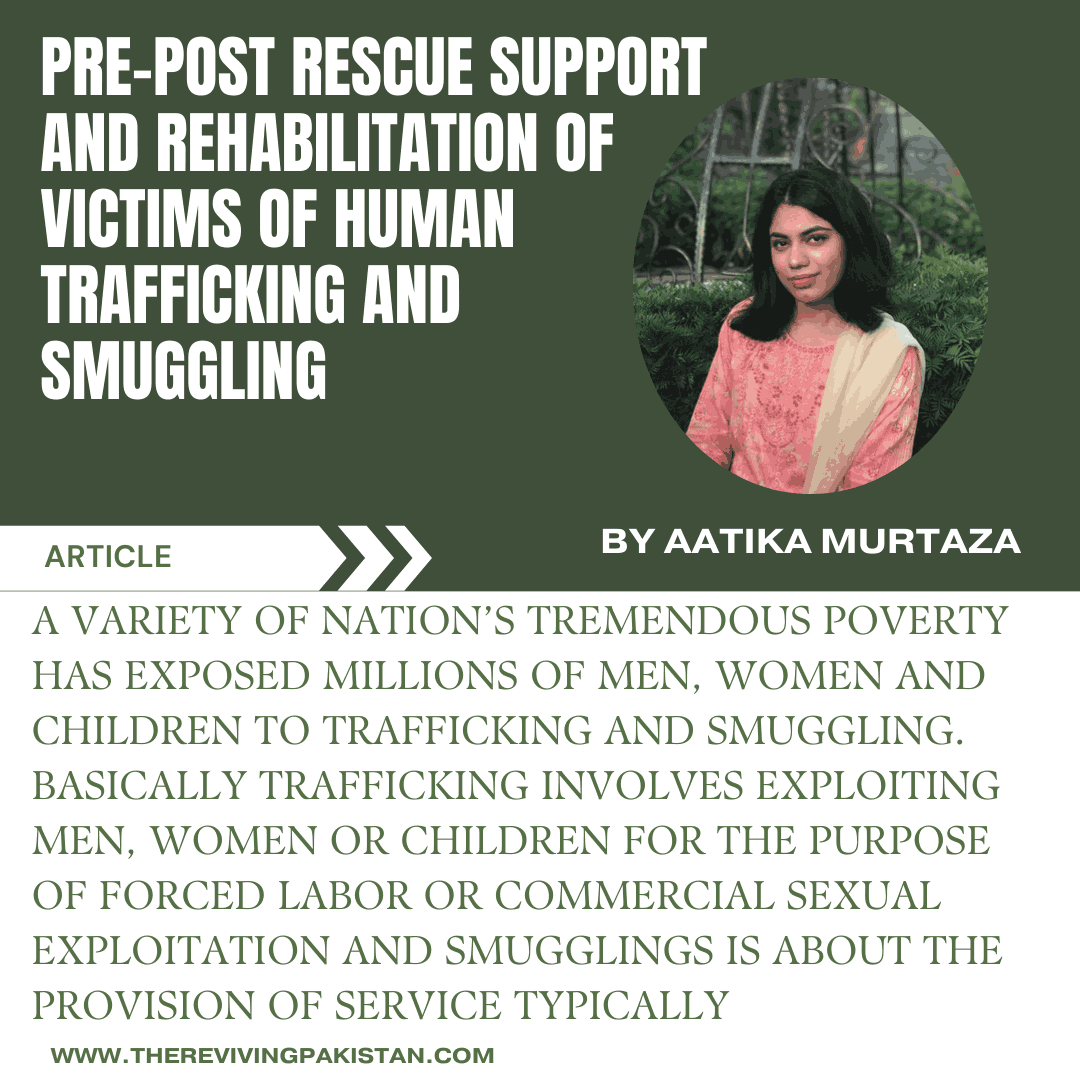About the Author(s)

Aatika Murtaza
Author has completed her bachelor’s degree in Environmental Science from International Islamic University, Islamabad. She is currently pursuing her master’s degree in Environmental Science from the National University of Sciences and Technology, Islamabad.
A variety of nation’s tremendous poverty has exposed millions of men, women and children to trafficking and smuggling. Basically trafficking involves exploiting men, women or children for the purpose of forced labor or commercial sexual exploitation and smugglings is about the provision of service typically, transportation or fraudulent documents to an individual who voluntarily seeks to gain illegal entry to a foreign country. Human trafficking also known as modern slavery, impacts approximately 40.3 million individuals worldwide and generates at least $150 billion in revenue for traffickers every year, making it one of the most lucrative crimes in history. The root causes of trafficking and smuggling are numerous but some common factors include poverty, globalization, restrictive labor and immigration regulations, natural calamities, political tyranny, armed warfare, and the absence of the rule of law, corruption, social and cultural behaviors that are harmful, purchase patterns and consumer demand. A number of countries across the globe are going through the increasing problem of human trafficking and smuggling; in certain instances, the governing bodies themselves are perpetrators. Some of the worst countries around the world for trafficking and smuggling include Algeria, Afghanistan, China, Pakistan, Iran, North Korea, Syria, Turkmenistan and so many others. Thousands of Pakistanis are crossing national boundaries illegally to reach Europe as a result of the two simultaneous problems of growing inflation and unemployment. In recent Greece boat tragedy, in open waters outside Greece, at least 350 Pakistanis overturned and drowned on June 04, 2023. Before that, on February 26, 2023, the boat carrying migrants from Pakistan, Afghanistan, Iran, and other nations when it left Turkiye, capsized in rough waves close to Steccato di Cutro, a coastal town on Calabria’s eastern coast killing 59 people out of 140 to 150. Through its funding of terrorist and criminal networks, these issues jeopardizes international peace and security. It endangers human rights by assisting oppressive governments all around the world. Through community disintegration and instability, it undermines global growth. Additionally, it serves as a multibillion-dollar criminal sector, which damages global economy.
Disasters interrupt lives and can leave victims feeling as though they have nowhere to turn or anybody to turn to. In these kind of situations, people may become more susceptible to exploitation such as human trafficking and smuggling. It is need of hour to prevent these growing crimes by making some pre-rescue strategies such as identification of vulnerable groups, public awareness campaign and by strengthening legal framework. Just like any other business, human trafficking and smuggling also has a demand and supply dynamic. Traffickers in person and smugglers establish offices in catchment region where they start the recruiting process, establish networks, and respond to a rise in demand, promote their legitimacy, and launch their illicit activities. For instance, women, girls, young boys and children are vulnerable to smuggling, moreover religious, and racial minorities like Christians, and Hazaras, as well as refugees and stateless people from Afghanistan, Bangladesh, and Burma, are particularly vulnerable to in-person trafficking in Pakistan. To reduce the vulnerability of specific groups to these illegal activities, it’s important to make them aware about their risk factor by properly educating them and by raising awareness campaigns. On May 17, 2022, a campaign to raise awareness of the dangers and difficulties associated with human trafficking and migrant smuggling in Pakistan was started by the Federal Investigation Agency (FIA) and United Nations Office on Drugs and Crime (UNODC) Country Officer for Pakistan (COPAK), executed using funding provided by the Canadian government through Immigration, Refugees and Citizenship Canada (IRCC). It includes the creation and distribution of awareness booklets, video streaming, posters, public service announcement on radio, social media accounts, and mobile Short Messaging Service (SMS) for the purpose of increasing awareness about the risks, problems, and obstacles linked to Trafficking in Person and Smuggling of Migrants. Pakistan has also declare two laws, Prevention of Trafficking in Persons Act 2018, and Prevention of Smuggling of Migrants Act 2018 as a legal instruments to effectively bring prosecutions against the organized gangs that are responsible for these offenses. At international level, The Worst Forms of Child Labour Convention was adopted by International Labour Organization in 1999. On August 04, 2020 the convention was signed by all members of International Labour Organization. In 2000, Protocol to Prevent, Suppress and Punish Trafficking in Persons, Especially Women and Children was adopted by United Nations General Assembly and it came into force on December 25, 2003. As of April 2022, 178 parties had approved it. Protocol against the Smuggling of Migrants was the first legal instrument ratified by the United Nations as a component of the UN Convention against Transitional Organized Crime in November 2000. As of March 15.2023, total 151 parties have signed the protocol. Despite having different strategies and legal instruments, there is a gap in implementation of these strategies and laws. A multidisciplinary and cross-sectoral strategies including all pertinent government and civil society participants are required to combat trafficking and smuggling in human beings. There is also a need to create a paradigm to promote accountability and sustainability.
Victims of trafficking and smuggling may have detrimental effects on their physical, mental, emotional, and financial health. Their interactions with family, friends, the community, and broader society might become tense and problematic as a result of their experiences with trafficking in person and smuggling. Immediate care, and safety, legal assistance, and rights, reintegration, and repatriation are some of the basic ways for addressing the impacts of these illegal activities. Services should be tailored to the interests and requirements of various victims and victims of all types of trafficking and smuggling in terms of rehabilitation. Even though certain assault victims just require one service such as return home, immediate medical attention, job placement etc. others require many services just like accommodation, psychological care, medical aid, legal assistance, education, practical training. A wide variety of educational possibilities are offered by many shelters, comprising official and causal schooling, practical training, and vocational education. Residents from other countries who desire to continue in the destination country to provide evidence against criminals may require particular protection. Some international and regional legal instruments also address the recovery and reintegration of victims. For instance, article 2 of UN Protocol (2000) advocates for steps to ensure the social, emotional, and physical healing of trafficking victims. UNOHCHR Recommended Principles and Guidelines on Human Rights and Human Trafficking (2000) call for the safe and willing repatriation of trafficked individuals, including relocation to the target country or to a third country. ASEAN Convention against Trafficking in Persons, Especially Women and Children (2015) implores ASEAN Member States to take action, to allow victims to remain either temporarily or forever and make their most effective efforts to support victim’s rehabilitation and ensure safer deportation. ACWC Guidelines and Procedures to Address the Needs of the Victims of Trafficking in Persons, especially women and children (2018) set up procedures for the safe, personally, timely, and supported return, recovery, and reintegration of those affected by trafficking, including risk evaluations, collaborative processes, and enough continual assistance for rehabilitation and reintegration. Different kind of issues and challenges may be faced by victims during recovery and reintegration process as it is an exhausting procedure that might take months or years to complete. In order to become more effective, there is a need to connect their services to wider networks of support that are more qualified to offer legal assistance, security, instruction and education to survivors while they are living in an asylum and when communicating with the victim throughout the protracted and frequently challenging process of reintegration. The processes of rehabilitation, recovery and reintegration include proper monitoring and consistency of medical care as an integral part. As it concluded, Trafficking-in-Person and Smuggling of human beings are becoming the worst crimes of 21st century around the globe especially more prevailing in developing countries like Pakistan. Women, children, young girls and boys being more vulnerable characterized by the misconduct and exploitation of individuals for sexual assault and compelled labor. Poverty, conflicts, political instability, corruption, lack of awareness, and education, weak law enforcement and demand of the market are some of the basic leading factors that contribute to pervasiveness of these illegal activities. To address these factors and to improve the economic, social, and political conditions in affected countries, the United Nation and many several nations have implemented laws and programs in order to combat human trafficking and smuggling. Because trafficking in persons and smuggling are clandestine crimes that are frequently underreported, it is challenging to access the effectiveness of these measures. Taking on human trafficking and smuggling demands a holistic approach which incorporates both prevention and follow-up assistance after rescue. When it comes to protecting the rights and well-being of victims, and hold offenders accountable, it is a complicated issue that need the cooperation of governments, civil society and international organizations. In order to eradicate such offenses, and ensure the protection and healing of survivors, ongoing enhancements to the pre-post rescue assistance and rehabilitation procedures are vital.

